Types of bushes for hedges are undersized. You can also use other plants. Other types of hedges
In our area it is not so often possible to meet a hedge, but in last years this method of landscaping is beginning to be actively used by our summer residents. And there is absolutely nothing surprising in this. Hedges not only play the role of a traditional fence, but are also extremely beautiful. Using thickets of shrubs, you can create a great place to relax. But what is the best thing to make a hedge?
Photo cypress lawson columnaris as a hedge
Left alone, most hedges will begin to expand at the top, where they will receive the most sunlight. A trimmed hedge should always be wider at the bottom and narrower at the top, whether it is flat, pointed or rounded. When cutting, start at the bottom and work your way up.
For absolute precision cutting, you can also use a line between the stakes to ensure a straight line at the top, but Roger prefers to rely on his eye for a more natural look. Remember that after you pounce on the top of the plant, it is more prone to snow because it will shed the snow easily. Tall hedges benefit from tethering for the winter - just be sure to use a rope or chain lock rather than hose-covered wire that can appear on chests if left for too long.
Kinds
First you need to figure out what they generally are. Only then can you think about which shrubs are best used in your specific case. First, they are divided into formed and freely growing (only occasionally trimmed). Of course, the first category is most often found on personal plots. An exception can be made if you need the original fencing of a pasture or vegetable garden.
Mistake #4: Trying to keep shrubs that are too tall or too wide for your space. If you're starting from scratch, choose plants that are amenable to hedging, which means they naturally grow upright and stiff - the words "columnar" or "shearable" in the name indicate this growing habit. shrubs will also need to tolerate shearing and frequent pruning, such as yew, private clothes, and boxwood. Typically, the hedge should be at least 3 feet wide.
When it comes to height, keeping the hedge at eye level will make maintenance easier; otherwise, be prepared to climb the stairs to get to the headwaters. The best course is to figure out how tall and wide you want your hedge to be before you plant. Study the habit of any plant you want to hedge, Roger says, then choose a variety that won't outgrow your space. Otherwise, you will be fighting uphill trying to cut the hedge down to size.
By height, all hedges can be divided into the following varieties:
- Tall, more than two meters.
- Medium height, from 50 cm to a couple of meters.
- Low, whose height does not exceed half a meter.
Other characteristics are closely related to the biological characteristics of the species that were used to create them:
Good choices for larger, more natural forms of evergreen hedges that require minimal pruning include western arborvitae, eastern red cedar, juniper, cypress, hemlock, white sap, and some varieties of holly. Where there is no need for four-season foliage, you may want to consider informal hedges. flowering shrubs such as forsythia, lilac, hydrangea, rose of sharon, cream myrtle or pink roses.
Mistake #5: Growing Hedging When You Really Need a Screen Landing. Hedging is generally maintained at 6 to 8 feet, and breeding stands can be raised as high as 30 feet. Evergreen hedges are very good for bedding and roofing edges, as well as small borders, bending in shape and depending on size, like dust, sound, windshield and visibility. Evergreen hedges are extremely durable and easy to care for. Due to less expansion than summer green hedges, they need less hedging cut and can be easily shaped.
- Evergreen and deciduous.
- With and without spines.
Main range
So what is the best way to make a hedge? Given that in the same England, such plantings are already one of the sides of the national culture, for many centuries basic recommendations have been developed that all gardeners should be aware of.
The older the evergreen hedges, the denser and fuller the habit. Evergreen hedges can be cut into different heights and various forms of hedging. Evergreen hedges offer in noble varieties also flowering direction and large fruit curtains. In this way, the ornamental value of hedge evergreens increases, and also justifies the greatest garden demands and a beautiful eye.
Hedge Evergreens - Is It Right for Me?
When deciding on evergreen hedges, the later feature is decisive. Would you like to plant a hedge with high decorative value, hedging appearance, if it looks fresh or rather noble?
Evergreen hedges for me - appearance of hedging
Because visibility is especially fast growing and dense evergreen hedges.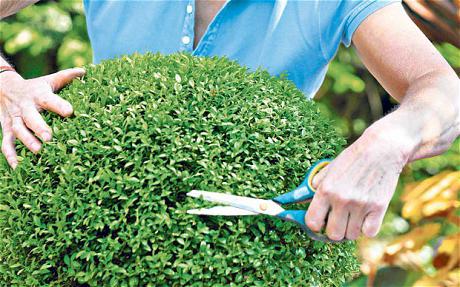 We will list the main types that can be used without any special restrictions in the climatic conditions of our country. We will not give a detailed biological characteristic, since data of this kind do not play a special role for these purposes. In general, based on the classification that we have given above, we can recommend a huge number of trees and shrubs. Consider what is better to make a tall category hedge.
We will list the main types that can be used without any special restrictions in the climatic conditions of our country. We will not give a detailed biological characteristic, since data of this kind do not play a special role for these purposes. In general, based on the classification that we have given above, we can recommend a huge number of trees and shrubs. Consider what is better to make a tall category hedge.
As noble, evergreen hedges are mostly compact and slow growing evergreen hedges. As fertile, evergreen hedges with high ornamental value, especially green hedge plants such as. Have you chosen a hedge? Then go to the selection and find more help to find "your" hedges!
Evergreen hedges should be cut several times a year. The more often the cut is made, the denser and more compact hedges are created. But a hedge can do more. It is ideal for delimiting individual sections and creating rooms. Really high so you can't view it. Just inside the garden is often not recommended. The main areas are separated.
Tall deciduous trees
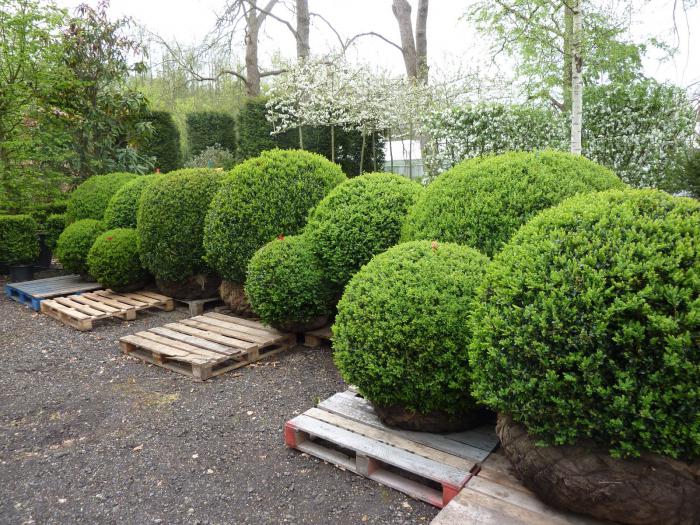
And what is the best way to make a hedge if these trees are not at hand? Mulberry is perfect, as well as common maple. We strongly do not recommend confusing the latter species with American maple, which, with its “impellers”, is able to turn hectares of land into thickets of its seedlings. If you need a barbed fence, you'll have to find
Fast-growing and evergreen hedges are the most popular, but deciduous plants should not be overlooked either. We have collected knowledge about the most popular fast growing hedge factories for the Central European region. Advantages and disadvantages fast growing plants hedging. Of course, you have good protection from looks, noise and wind in a fast growing hedge in just a few years, but there are more than just benefits.
Faster is often a good noise-proof windshield rather than all hedges, and bamboo, for example, is a bit windy. Natural border If the planting distance is correct, the hedge is tight, you don't need a fence in the normal case. Disadvantages - Hedges usually don't stop growing. To keep them at the right height, they need to be cut, often more than once a year. - Fast growing hedges usually need to be scaled back rather than slowly growing. This must be disposed of. - Needle hedge waste cannot be used for or due to the resin content. - Many trees of life, as well as the Leyland cypress, make a small garden very dark and make it even smaller.
For aesthetic hedges, you can plant lilacs, honeysuckle (delicious fruits), currants and meadowsweet, as well as acacia, shadberry and mountain ash. As for the irgi (beautiful fast-growing hedge), then it will have to be constantly thinned out, getting rid of young shoots growing in all directions. In addition, during the fruiting season, a huge number of sparrows will gather on these trees, which is far from desirable in all cases.
In winter, they change their color to an unattractive green-brown. Fast growing hedging plants. First differentiates between foliage and hedge of needles. Then there are still low hedges, hedges up to 2 meters high cut and hedges that are higher. Therefore, it is always important what height you want to achieve.
Deciduous hedges
Difference between hedgehogs, in summer green and winter green or evergreen hedges. Evergreen trees provide protection all year round, but also on deciduous plants there are some which keep their leaves for a very long time, often until a new expulsion, so that the visibility is also almost uninterrupted. Therefore, you need to think in advance which of the hedges you are buying. Winter hardness should also be taken into account. and are in fact the perfect hedge plants: evergreen, with beautiful foliage and gorgeous flowers, fast growing, sparse, fairly cheap and much more.
thorny hedges
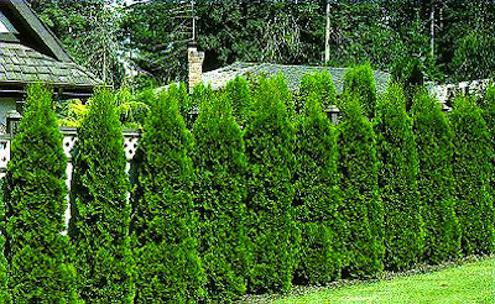 For these purposes, scarlet pyracantha is widely used. It is not very common, as it is suitable only for the southern regions. Forms very dense hedges, decorated with orange-yellow berries, which remain on the bush for a very long time. A plant with a curious name has proven itself in arid conditions, as it is practically not picky about soil quality and irrigation.
For these purposes, scarlet pyracantha is widely used. It is not very common, as it is suitable only for the southern regions. Forms very dense hedges, decorated with orange-yellow berries, which remain on the bush for a very long time. A plant with a curious name has proven itself in arid conditions, as it is practically not picky about soil quality and irrigation.
However, they are not ideal for our climate unless you live in a wine-growing climate. Every spring you can see a lot of brown sequins and cherry orchids where you can hardly see any green. In frosty and sunny winters, plants suffer greatly and often do not survive. The hedge looks bad and quite often some or all of the hedge needs to be updated.
Fast-growing foliage of trees that is reduced annually to a dense hedge. Particularly beautiful are the leaves in bronze tones, the numerous green-yellow flowers in May and the fall color in bright yellow-orange. This is a deciduous shrub. Segment: before a firefight in spring or autumn.
- Location: sunny to shady.
- Soil: normal garden.
This also includes the same juniper and thuja, hawthorn and even the hornbeam we mentioned. Of course, in this case, you will have to put more effort into its constant shaping and cutting.
We make low-growing hedges
In another way, they are also called curbs. The range of species in this case is not so wide, so there is not much to choose from.
Plants are very sparse, can be cut to any height and width. Flowering in May is quite imperceptible. From July, winged fruits develop. The hornbeam branches are very dense and very regenerating. Location: Full sun to deep shade. Soil: normal earth, also sandy or nutritious. Cut: very cut. Can also be put on a stick. Best in the spring before you cut Start!
- Height: depending on the cut of the fence.
- Maybe several meters.
- Width: depending on the cut.
- It can also be several meters.
Firstly, evergreen boxwood may come up. Very shade tolerant, extremely slow growing. In addition, in most of our regions, in cold winters, it has a tendency to freeze. The hedge also proved to be quite “loose”, but it blooms very beautifully, and its berries are very decorative. In addition, this shrub belongs to the category of shade-tolerant.
However, here again there is a problem with winter hardness. That's why it's not an alternative to Kirschlber. Iskra has beautiful glossy leaves, the flowers are extensive and decorative, the leaf is often colored, and the whole appearance wonderful. In addition, the plant cuts well. For wine regions ideal for planting in all other restricted areas.
If you need effective visual protection for your garden, you can hardly get anywhere without shrub growth. The natural visible walls of wooded plants fit perfectly into the existing landscape and decorate your garden with beautiful flower and interesting fruit decoration. Which bushes are very fast, we have compiled a small list for you.
It is extremely important to adhere to the dates of disembarkation in open ground, as well as choosing the right soil and the types of fertilizers used. The earlier you plant a tree, the easier it will be in the future. Deciduous cultures best tolerate transplantation at 2-3 years, and conifers at a maximum of five years. The fact is that it is from this age that it is best to start molding plants.
Advantages and disadvantages of fast growing shrubs
Fast growing shrubs and hedge plants are fine as tall and dense hedges - but only if planted and cared for properly. Keep in mind that fast growing hedges need to be cut more often, but this is not necessarily a disadvantage.
However, in the case of fast growing shrubs, you will have a large number of branches and branches that need to be disposed of after cutting the hedge. Especially in fast-growing evergreen hedges with needles, cut material does not enter the compost due to the relatively high resin content.
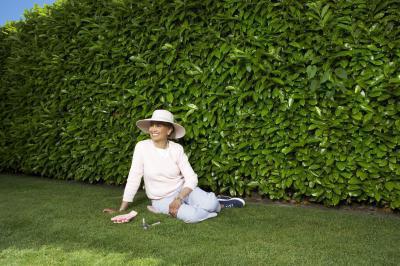 Secondly, be sure to mark the landing site by pulling a twine for this purpose. Don't try landing "by eye" as you are unlikely to be able to achieve a truly direct landing based solely on your eye gauge. A beautiful hedge, the photo of which is in the article, always has regular geometric shapes.
Secondly, be sure to mark the landing site by pulling a twine for this purpose. Don't try landing "by eye" as you are unlikely to be able to achieve a truly direct landing based solely on your eye gauge. A beautiful hedge, the photo of which is in the article, always has regular geometric shapes.
Selection of fast growing shrubs
However, soil, water and light conditions are always critical for proper plant growth. The following hedge plants offer you safe visibility from prying eyes. Thuja with straight, vertical growth usually stands in the form of a column or pyramid.
Their needles smell of fragrance and therefore attract many birds. Lorbekerkirche is from the Rosengevace family and has nothing to do with real laurel. Gardeners appreciate these hedges because of their everlasting white and beige flowers. Bay cherries are not particularly demanding to care for, as they can easily tolerate longer drying periods or heavy freezes. The shrub has a red autumn color and is very beautiful in dark red annual shoots. Red hard bones are summer green shrubs growing up to 5 m in height.
How to plant?
Depending on the number of rows, we dig a trench of the required width. Please note that gaps of at least 60 centimeters should be left between plants (if the fence is free, then from 1.5 meters), and gaps of 25-50 cm should be made between rows. If planting in two or more rows, use a checkerboard pattern.
Be sure to take care of the fertility and moisture of the soil. If there is such a need, it is advisable to apply the necessary types of mineral and / or organic fertilizers, after which the planting holes should be properly watered. If we are talking about hardwoods, then the root system of trees should be kept in water for a couple of hours before planting, and then dipped in liquid clay (creamy consistency) mixed with humus.
The landing itself is also highly desirable to do according to the level. Near each planted plant, it is necessary to carefully compact the soil. It is necessary to water each bush in two or three passes, so that the water has time to be absorbed and reach the roots of the plants. As for conifers, they should generally be planted along with the clod of earth with which they were acquired. In this case, the hedge, for which plants sometimes have to be bought, has a better chance of surviving.
Trimming and shaping
After planting, plants should never be pruned. This event has been postponed for at least one year. Some breeds may be an exception. coniferous trees. Subsequently, the plants are pruned at the moment when their young shoots begin to slightly lignify. At least two live buds should be left on each branch.
 As for the annual growth, in the first two or three seasons, a minimum of 15-20 cm should be left, subsequently reducing this value to a couple of centimeters. It is best to shorten the plants in early spring, as well as three times throughout the summer. Attention! The last pruning should be done at least one month before the onset of stable cold weather.
As for the annual growth, in the first two or three seasons, a minimum of 15-20 cm should be left, subsequently reducing this value to a couple of centimeters. It is best to shorten the plants in early spring, as well as three times throughout the summer. Attention! The last pruning should be done at least one month before the onset of stable cold weather.
Care
It should not be forgotten that the hedge, the bushes of which adorn your site, is not maintained by a single pruning. She needs watering, weeding from weeds and top dressing with fertilizers. As a rule, throughout the growing season, 50-100 grams of fertilizer per linear meter should be applied. Top dressing is performed three times. At the beginning of summer, nitrogenous fertilizers are used, by autumn they switch to phosphorus ones.
In the early years, weed control can be very labor intensive. At a distance of about 10-15 centimeters from the edge of the hedge, you need to mow all the weeds, as it takes away the moisture they need from the plants and nutrients. Only in this way can the best hedge be obtained.
What is a living fence? A hedge is a dense planting of a group of shrubs in one or more rows to create a barrier similar to a standard fence. If you decide to create a hedge with your own hands, then we can say that you have chosen one of the best options fences. Hedges are used not only to fence the perimeter of the site, but also to break it into zones. A hedge is planted in the autumn. So the plants will better take root and become stronger in the ground.
A hedge is much more useful in a garden than a fence made of brick, stone, wood, or metal. For example, on hot summer days, a hedge creates a good atmosphere, shading the garden a little and this gives coolness. Various beneficial insects and birds can find shelter in it.
The hedge needs to be trimmed, formed 1 - 2 times a year, otherwise it will grow willfully, which will reduce the decorative and practical function of the bushes. Practical - because evenly trimmed hedge allows you to conveniently move around the garden. Be prepared for the fact that some plants grow slowly, although they are much more decorative than their fast-growing comrades. Therefore, you will have to wait until the hedge grows to the desired height and width.
If you are planning to replace the usual, banal fence with a hedge, then the best period for its creation is the end of summer, the beginning of autumn. Hedge planting can begin at the end of August and continue until mid-September.
In order to create a green hedge in your area, you need to either grow the plants yourself, or buy coniferous or hardwood. If you do not want to wait until the green hedge from small plants grows into quite tall ones, then you can buy plants from the nursery of the height you need.
Planting a hedge. First you need to decide on the type of plants, the height of the green hedge and the place for the hedge. A place for a hedge should be marked with a cord or sprinkled with a thin line of sand. The fact is that shrubs for hedges are most often planted not in separate pits, but in a trench. Choose a hedge plant that suits your preferences. Study well its characteristics, height in adulthood, care for this plant. By growing bushes or purchasing them in special. stores, it is desirable to drop them on the same day. Dig a trench along the marked line. The depth and width of the trench depends on the earthen coma of the root system. Always make holes, trenches 5 - 10 cm larger than the plant's earthen ball. We will fill these gaps between the ground and the clod with nutrient soil. You also need to put peat, humus, manure or compost on the bottom. Only conifers do not need so much nutritious soil, otherwise they will “burn out” from excess. Bushes are planted at the same distance in the prepared trench and the earth around the earthen clod is slightly pressed. The distance depends on the size and type of bushes. Immediately after planting or the next day, the plants are trimmed, especially cutting out long and unbranched shoots. Do not be afraid of a cardinal haircut, literally in 2 - 3 weeks the bushes will become lush, new branches will be released. For several weeks, the hedge should be watered with high quality to the depth of the roots, since a lot of water is needed for the development of the bushes.
In order for the bushes to grow well, you should choose them not only for their beauty, but also for how well they will feel on your soil in the climate of your area. For example, we will tell you about the 11 most famous, popular, well-growing in middle lane shrubs. So let's go...
Yew berry photo:
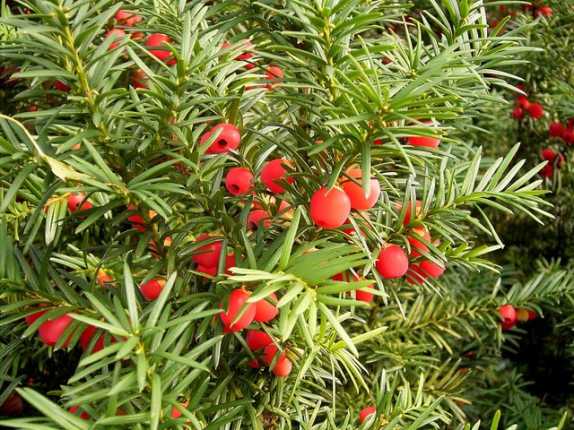 1. Yew berry (Taxus baccata)- one of the most popular coniferous centenarians, with good care can live up to 1000 years. Grows well in well-drained, loose, permeable soils. It can be used for hedges from one to four meters high. It tolerates a haircut and the formation of a bush, grows slowly, so you need to cut it once a year. It develops normally both in the shade and in the bright sun, but in the spring you need to cover it a little, since the bright sun in the spring can make it “burn” on it. Since it grows slowly, you need to wait for its normal development so that planting can be called a hedge. The fleshy part of the yew fruit is edible, but the seeds and other parts of the plant are poisonous - warn the children about this!
1. Yew berry (Taxus baccata)- one of the most popular coniferous centenarians, with good care can live up to 1000 years. Grows well in well-drained, loose, permeable soils. It can be used for hedges from one to four meters high. It tolerates a haircut and the formation of a bush, grows slowly, so you need to cut it once a year. It develops normally both in the shade and in the bright sun, but in the spring you need to cover it a little, since the bright sun in the spring can make it “burn” on it. Since it grows slowly, you need to wait for its normal development so that planting can be called a hedge. The fleshy part of the yew fruit is edible, but the seeds and other parts of the plant are poisonous - warn the children about this!
In addition to wild yew, a straight-growing yew hybrid ‘Hicksii’ (Taxus x media) with hard, fresh greens is also used for hedges.
Thuja western photo:
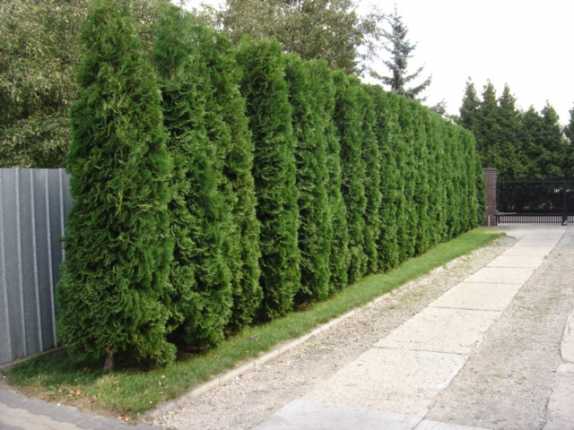 2. Thuja western (Thuja occidentalis)- this plant forms dense shoots well, wind - and frost-resistant. It can be used for hedges from two to four meters high. Grows in full sun with rich, moist soil.
2. Thuja western (Thuja occidentalis)- this plant forms dense shoots well, wind - and frost-resistant. It can be used for hedges from two to four meters high. Grows in full sun with rich, moist soil.
Ordinary, inexpensive thuja grows rapidly and will reach eye level in a few years. In order for their thuja to create a solid wall, you need to cut it twice a year. It must be planted in moist and loose soil. But severe drought or stagnant water lead to fungal diseases.
No need for a strong, radical haircut, because after that the thuja will not turn green again. It is better to cut only extra branches or the tops of the branches themselves. There is a large selection of thuja varieties with different needle colors, different heights and crown shapes. But for hedges, the slow-growing variety ‘Smaragd’ is best suited, which also retains winter time its green color.
Cypress Lavson photo:
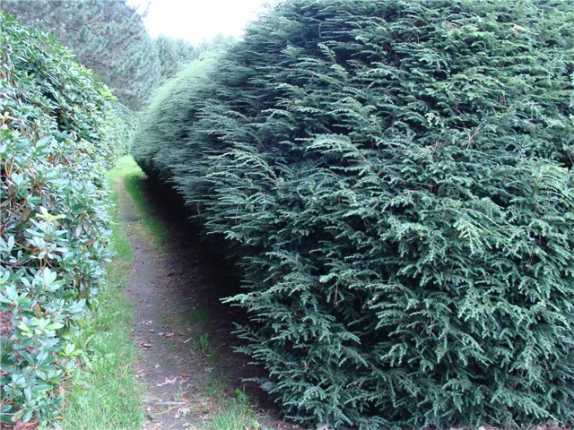 3. Lawson's cypress (Chamaecyparis lawsoniana)- very similar to thuja, but cypress has thinner and more delicate scaly leaves. Its uniqueness lies in the fact that it has varieties with blue, yellow, gray leaves. It grows well in sunny or semi-shady places on moderately moist soils. It is more wind- and frost-resistant than thuja, but just like thuja does not like strong haircuts. You need to shear once a year. The best variety for hedges is the blue-green 'Columnaris'.
3. Lawson's cypress (Chamaecyparis lawsoniana)- very similar to thuja, but cypress has thinner and more delicate scaly leaves. Its uniqueness lies in the fact that it has varieties with blue, yellow, gray leaves. It grows well in sunny or semi-shady places on moderately moist soils. It is more wind- and frost-resistant than thuja, but just like thuja does not like strong haircuts. You need to shear once a year. The best variety for hedges is the blue-green 'Columnaris'.
Cherry laurel photo:
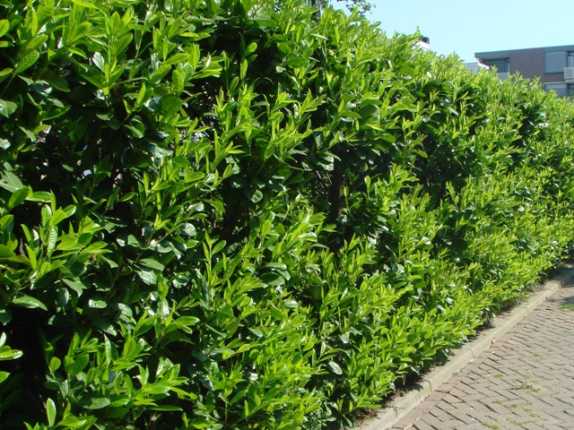 4. Laurel cherry (Prunus laurocerasus) — evergreen shrub belonging to the subgenus Cherry of the genus Plum, like this ...
4. Laurel cherry (Prunus laurocerasus) — evergreen shrub belonging to the subgenus Cherry of the genus Plum, like this ...
Grow to create a hedge from one to two meters in height. Laurel cherry is not whimsical, can grow on dry soils and with dry wind, tolerates both open sunny places and deep shade of trees. This shrub with its glossy leaves is suitable for decorating a Mediterranean style garden. Cherry laurel grows widely, so it is preferable to cut it with garden shears once or twice a year. For hedges, varieties with upright branches, such as ‘Herbergii’ or ‘Rotundifolia’, are well suited.
Evergreen holly holly photo:
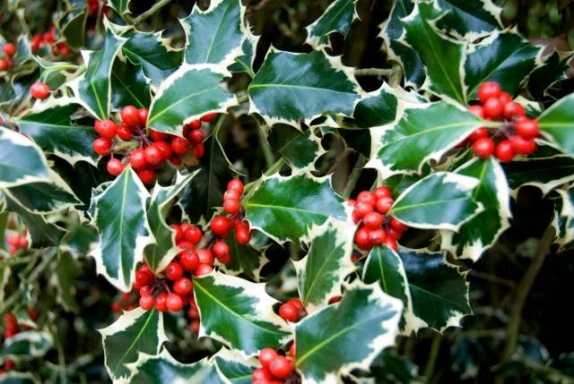 5. Evergreen holly (Ilex aquifolia)- from it create a hedge with a height of one to two meters. Likes semi-shady, protected places with nutritious, loose soil. Not suitable for cold regions, as variegated varieties often suffer from frost. You need to cut it once a year, the holly grows slowly. Not only variegated leaves are decorative, but also yellow or bright red berries. Although the holly is beautiful, beauty requires sacrifice - it is often affected by mining flies. The best varieties for hedges are ‘Siberia’ or ‘Heckenstar’ (Ilex x meserveae) and ‘I. C. van Tol'.
5. Evergreen holly (Ilex aquifolia)- from it create a hedge with a height of one to two meters. Likes semi-shady, protected places with nutritious, loose soil. Not suitable for cold regions, as variegated varieties often suffer from frost. You need to cut it once a year, the holly grows slowly. Not only variegated leaves are decorative, but also yellow or bright red berries. Although the holly is beautiful, beauty requires sacrifice - it is often affected by mining flies. The best varieties for hedges are ‘Siberia’ or ‘Heckenstar’ (Ilex x meserveae) and ‘I. C. van Tol'.
Common privet photo:
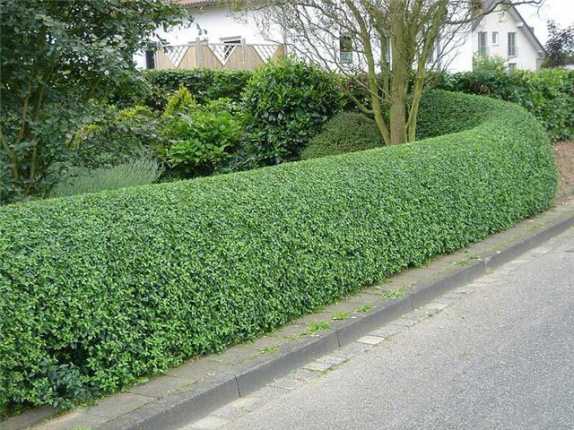 6. Common privet (Ligustrum vulgare)- one of the gardeners' favorite hedge plants because it is very unpretentious. It can grow both in the shade and in bright sun, and on any soil. In a hedge, it can reach sizes from one to three meters. The plant is fast growing and creates a dense hedge, so it needs to be trimmed 2 times a year. Groomed bushes can be formed with a cardinal haircut. Birds are very fond of privet - in dense thickets of branches they build nests and incubate chicks, and berries that are poisonous to humans are fed to birds.
6. Common privet (Ligustrum vulgare)- one of the gardeners' favorite hedge plants because it is very unpretentious. It can grow both in the shade and in bright sun, and on any soil. In a hedge, it can reach sizes from one to three meters. The plant is fast growing and creates a dense hedge, so it needs to be trimmed 2 times a year. Groomed bushes can be formed with a cardinal haircut. Birds are very fond of privet - in dense thickets of branches they build nests and incubate chicks, and berries that are poisonous to humans are fed to birds.
Although privet sometimes disturbs gardeners with creeping shoots and a powerful root system, which can interfere with other plants growing closely. In winter, most varieties do not retain foliage, forming a hedge of dense thickets of thin branches, but the Atrovirens variety and oval-leaved privet retain their foliage better in winter.
Boxwood evergreen photo:
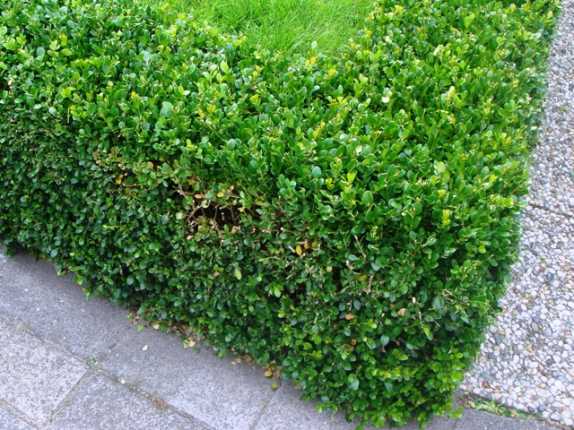 7. Boxwood evergreen (Buxus sempervirens)- we can say that this is one of the most common shrubs for creating landscape design. Even in medieval Europe, he was in the first place in the creation of hedges, borders and topiary figures. Since boxwood grows very slowly, it reaches up to 1 m in height in hedges. Grows well in sun and shade. The soil prefers nutritious, humus, well-permeable, loose, not dry.
7. Boxwood evergreen (Buxus sempervirens)- we can say that this is one of the most common shrubs for creating landscape design. Even in medieval Europe, he was in the first place in the creation of hedges, borders and topiary figures. Since boxwood grows very slowly, it reaches up to 1 m in height in hedges. Grows well in sun and shade. The soil prefers nutritious, humus, well-permeable, loose, not dry.
Boxwood bushes grow thicker and thicker as they grow. They tolerate a haircut well, no more than once a year. A cardinal haircut is not desirable, as it will take a long time to grow young greenery. Sometimes, in adulthood, it is affected by the fungus Cylindrocladium and symptoms may appear - dark brown spots and white bloom on the leaves.
To form low, compact hedges, 'Suffruticosa' and 'Blauer Heinz' can be planted, and for taller hedges, the wild species Buxus sempervirens is suitable.
European beech photo:
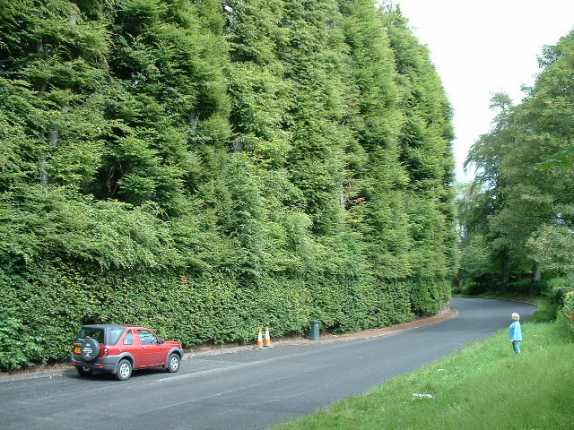 8. European beech (Fagus sylvatica) and purple forest beech (Fagus sylvativa var. purpurea)- are long-lived trees for creating hedges in height from one and a half to four meters or more. Grow well in moist and nutritious soils, in the shade and in the sun. Shearing is done twice a year. Dark - green leaves in autumn they turn yellow-orange. Decorative foliage lasts a very long time, until the onset of snowfall. It is necessary to ensure that the soil where the beeches grow is not very wet, the trunks and roots of the beeches suffer greatly from an excess of water.
8. European beech (Fagus sylvatica) and purple forest beech (Fagus sylvativa var. purpurea)- are long-lived trees for creating hedges in height from one and a half to four meters or more. Grow well in moist and nutritious soils, in the shade and in the sun. Shearing is done twice a year. Dark - green leaves in autumn they turn yellow-orange. Decorative foliage lasts a very long time, until the onset of snowfall. It is necessary to ensure that the soil where the beeches grow is not very wet, the trunks and roots of the beeches suffer greatly from an excess of water.
Common hornbeam photo:
 9. Common hornbeam (Carpinus betulus)- despite the fact that it is also called white beech because of the silvery-gray bark, it still belongs to the Birch family. It is unpretentious, grows in the sun and in the shade, tolerates drought and excess moisture well. Shearing is done twice a year. Bright green leaves turn lemon yellow in autumn and fall a little earlier than beech leaves.
9. Common hornbeam (Carpinus betulus)- despite the fact that it is also called white beech because of the silvery-gray bark, it still belongs to the Birch family. It is unpretentious, grows in the sun and in the shade, tolerates drought and excess moisture well. Shearing is done twice a year. Bright green leaves turn lemon yellow in autumn and fall a little earlier than beech leaves.
Maple field photo:
 10. Field maple (Acer campestre)- a low, slender tree that is best planted in landscape gardens. Used to create a hedge of two to four meters. It grows well both in the sun and in partial shade, grows on any soil except acidic and waterlogged. Maple grows quickly, so it needs to be cut twice a year, it normally tolerates a radical haircut right up to lignified branches. Not afraid of drought, heat, dry wind. Leaves turn golden yellow in autumn and fall off in winter. Maples are sometimes damaged by powdery mildew. And because of the rapid growth, they sometimes look like groomed shrubs. Birds love to nest in the dense branches of the field maple.
10. Field maple (Acer campestre)- a low, slender tree that is best planted in landscape gardens. Used to create a hedge of two to four meters. It grows well both in the sun and in partial shade, grows on any soil except acidic and waterlogged. Maple grows quickly, so it needs to be cut twice a year, it normally tolerates a radical haircut right up to lignified branches. Not afraid of drought, heat, dry wind. Leaves turn golden yellow in autumn and fall off in winter. Maples are sometimes damaged by powdery mildew. And because of the rapid growth, they sometimes look like groomed shrubs. Birds love to nest in the dense branches of the field maple.
Barberry Thunberg photo:
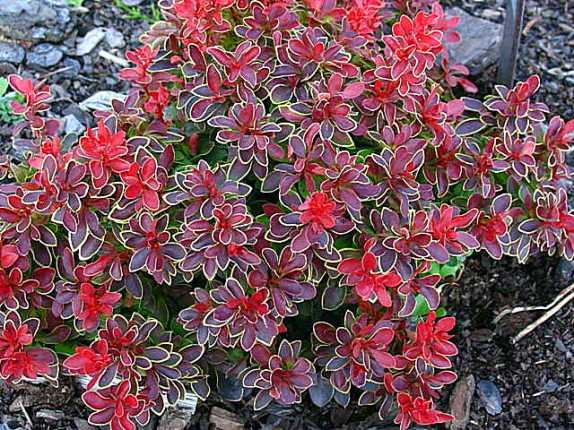 11. Thunberg barberry (Berberis thunbergii)- slow-growing shrub, forming a spherical shape. Barberry is grown in hedges up to one and a half meters in height. Its short branches have sharp thorns, so this shrub is best suited to protect your site from uninvited animals. Although the barberry grows slowly, it still needs to be trimmed twice a year. If the barberry is running, then a radical haircut will do. Barberry foliage is decorative - different varieties have green, yellow, purple and variegated color. And in autumn, the leaves become richly bright - crimson. The coral fruits of the barberry are also decorative, which stay on the branches until severe frosts.
11. Thunberg barberry (Berberis thunbergii)- slow-growing shrub, forming a spherical shape. Barberry is grown in hedges up to one and a half meters in height. Its short branches have sharp thorns, so this shrub is best suited to protect your site from uninvited animals. Although the barberry grows slowly, it still needs to be trimmed twice a year. If the barberry is running, then a radical haircut will do. Barberry foliage is decorative - different varieties have green, yellow, purple and variegated color. And in autumn, the leaves become richly bright - crimson. The coral fruits of the barberry are also decorative, which stay on the branches until severe frosts.
DIY hedge video:
Autumn haircut hedge video:
Do GOOD, SHARE this page in the social. networks
In contact with



